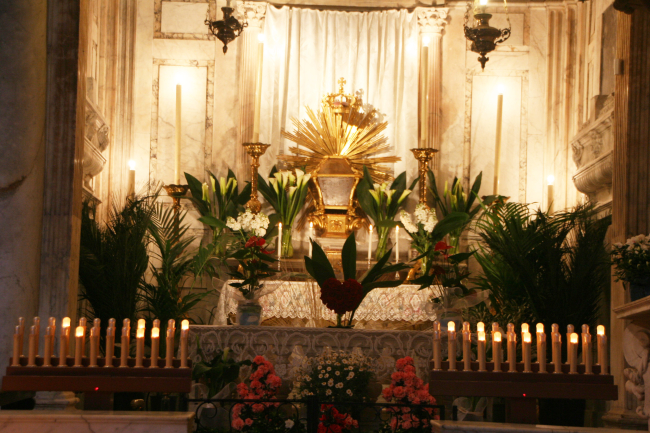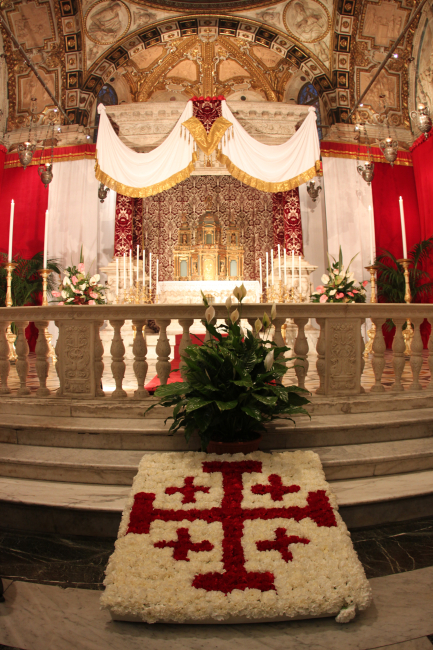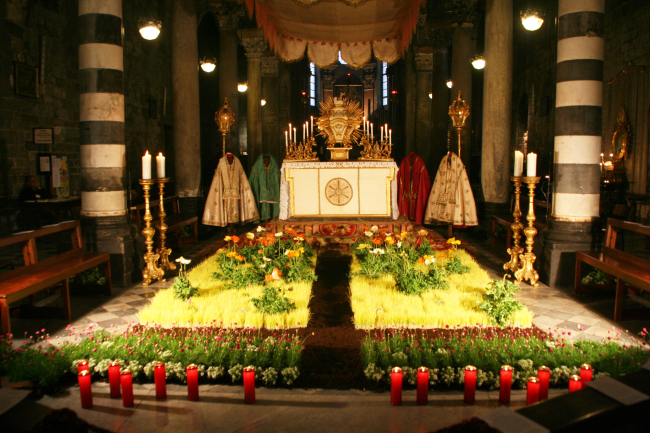Holy Weeks Rites
Christian Easter is the oldest, most solemn feast on the liturgical calendar: initially intended to commemorate the day of the death of Jesus, it has over the centuries come to represent the resurrection.
The oldest evidence of Easter in Genoa dates back to the Middle Ages, when the tradition of the so-called "Sepolcri" ('Tombs', or altars of the Deposition) was already widespread: the custom of decorating the altar of the Eucharist following the afternoon liturgy on Maundy Thursday – the "In Coena Domini" mass – was established in Genoa in the second half of the 15th century, with strong support from movements of popular devotion known as the Confraternite dei Disciplinanti (Confraternities of the Dutiful). The custom expanded in the Renaissance and spread further still in the Baroque period.
The altars of churches and convents were adorned with flowers and fabrics, as well as with vases of wheat, thin, pale blades of grass harvested from the blessed grains sown on the feast of St. Blaise (February 3) and grown in the shade.
In the second half of the 17th century, the custom of placing "cartelami" - figures painted on carved frames - in the tombs of Liguria's churches also became widespread, allowing for scenes from the Passion to be staged. Often, in order to depict the Passion in a more engaging way, the painted scenes and statues were joined in the 19th century by human figures, dressed in soldier costumes, complete with lances gripped in their fists.
Tradition dictated that an odd number of churches with decorated tombs be visited, leading some of the faithful to spend hours walking and roaming through ancient alleys and arcades towards the sea.
The tradition of decorating the tombs and visiting an odd number of them continues to this day. The most frequently visited tomb is the one in the Cathedral at the altar of St. John the Baptist, decorated with a silver parament and Corpus Christi chest from 1612, along with exquisite brocades and colourful flowers.
The tomb of the Church of Gesù is famous to this day for its rather unusual form and colours: the tradition of placing a grand floral bouquet before the tomb comes from the noble Pallavicini family, who gave generously to the church of Gesù ever since its foundation.
Close to the Cathedral, in the Museo Diocesano, visitors can admire the magnificent "Mysteries of the Passion", depicted on yards upon yards of the blue canvas (the famous fabric dubbed "Genoa blue", better known as denim) once used as paraments to adorn the "Sepolcri", lending both an ornamental and an illustrative/devotional effect.
The Maundy Thursday Procession in the heart of Genoa's historic centre is a spectacle not to be missed. Tribute is paid to the tombs by the Casacce: this union of Confraternities parades in processions permeated with pathos, in order to visit the Blessed Sacrament, displayed in the seven oldest churches of the historic centre. At least as far back as the 16th century, the Confraternities would all come out for the Easter processions, so the main gates of the city had to be kept open into the evening to allow for the return not only of the Confraternity of Santa Zita to its Oratory located "outside the walls", but also of all the people who had come into town from their homes to attend the sacred rites.



